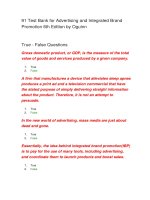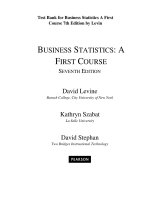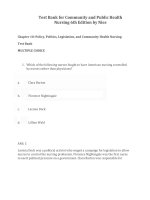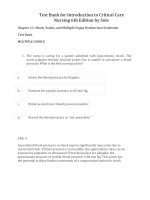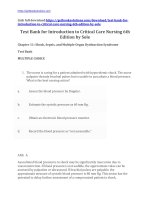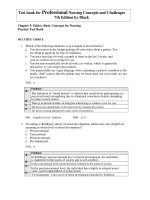Test bank for the essentials of family therapy 6th edition by nichols download
Bạn đang xem bản rút gọn của tài liệu. Xem và tải ngay bản đầy đủ của tài liệu tại đây (127.63 KB, 5 trang )
Chapter 2
Test Bank For The Essentials of Family Therapy
6th Edition by Nichols
Multiple Choice
1. Lyman Wynne’s term for the façade of family harmony that characterized
many schizophrenic families is:
a. pseudocomplementarity
b. pseudomutuality
c. pseudoharmony
d. pseudohostility
Answer: b
2. Hospital clinicians began to acknowledge and include the family in
an individual’s treatment when:
a. they noticed when the patient got better, someone in the family got worse
b. they realized the family was footing the bill for treatment
c. they realized the family continued to influence the course of treatment
anyway d. a and c
e. none of the above
Answer: d
3. Kurt Lewin’s idea of ______ can be seen in action in Minuchin’s promotion
of crises in family lunch sessions, Norman Paul’s use of cross-confrontations,
and Peggy Papp’s family choreography.
a. unfreezing
b. social equilibrium
c. group process
d. field theory
Answer: a
4. Paying attention to how members of a group interact rather than merely to what
they say is called:
a. Basic assumption theory
b. Group dynamics
c. Field theory
d. Process/content distinction
Answer: d
5. The first to apply group concepts to family treatment
was: a. Murray Bowen
b. John Elderkin Bell
c. Virginia Satir
d. Carl Whitaker
Answer: b
6. A second, covert, level of communication which conveys something about how
the communicants should relate is called:
a. denotation
b. connotation
c. metacommunication
d. didacticism
Answer: c
7. Frieda Fromm-Reichmann’s concept, “______ mother,” described a
domineering, aggressive, rejecting, and insecure mother who was thought to
provide the pathological parenting that produced schizophrenia.
a. undifferentiated
b. schizophrenogenic
c. reactive
d. symbiotic
Answer: b
8. According to Wilfred Bion, most groups become distracted from their primary
tasks by engaging in patterns of:
a. fight-flight
b. pairing
c. dependency
d. any of the above
e. all of the above
Answer: c
9. Ivan Boszormenyi-Nagy emphasized the importance of ______ in families.
a. communication
b. ethical accountability
c. triangles
d. systems dynamics
Answer: b
10. Gregory Bateson and his colleagues at Palo Alto introduced this concept
to describe the patterns of disturbed family communication which cause
schizophrenia.
a. schizophrenogenesis
b. double bind
c. pseudohostility d.
none of the above
Answer: b
11. The only means to effectively escape a double bind is to:
a. withdrawal from the relationship
b. metacommunicated
c. quid pro quo
d. a and b
Answer: d
12. According to Theodore Lidz, marital schism occurs when: a.
one spouse with serious psychopathology dominates the other b.
there is a chronic failure of spouses to achieve role reciprocity
c. one spouse consistently engaged in double-binding communication
d. there is a loss of autonomy due to a blurring of psychological
boundaries between spouses
Answer: b
13. Jackson’s concept, ______, that families are units that resist change, became
the defining metaphor of family therapy’s first three decades.
a. emotional reactivit
b. quid pro quo
c. family homeostasis
d. a and c
Answer: c
14. A ______ relationship is one based on differences that fit together.
a. complimentary
b. symmetrical
c. homeostatic
d. imbalanced
Answer: a
15. This family therapist’s personal resolution of emotional reactivity in his
family was as significant for his approach to family therapy as Freud’s selfanalysis was for psychoanalysis.
a. Salvador Minuchin
b. Jay Haley
c. Murray Bowen
d. Carl Whitaker
Answer: c
16. This family therapist believed in the existence of an interpersonal
unconscious in every family.
a. Murray Bowen
b. Nathan Ackerman
c. Ivan BoszormenyiNagy d. Virginia Satir
Answer: b
17. The restructuring techniques of structural family therapy are designed to bring
about:
a. first-order change
b. second-order change
c. ethical accountability
d. transmuting interpretations
Answer: b
18. The group therapy model was not entirely appropriate for families for
what reason?
a. family members are peers
b. families have a shared
history c. both a and b
d. none of the above
Answer: b
Short Answer
1. Describe the “double-bind theory” of schizophrenia. Historically, why was the
theory important?
2. How are family systems therapies different from traditional individual therapies?
3. Some would argue that there is a radical divergence between family systems
therapies and the more traditional psychotherapeutic approaches. Others would
challenge this view, arguing that there are many points of similarity and that the
differences are exaggerated. Take one position or the other and defend your stand.
4. Choose two of the individuals below and describe how they helped to launch
the family therapy movement. Be specific in discussing their contributions to the
field. a. Gregory Bateson
b. Theodore Lidz c.
Milton Erickson d.
Nathan Ackerman e.
Murray Bowen
f. Don Jackson
g. Jay Haley
h. Salvador Minuchin
i. Virginia Satir
j. Carl Whitaker
5. How is group therapy similar to and different from family therapy?
6. What is the positive impact of research on family dynamics and
schizophrenia? What was its negative impact?
7. What are some of the factors that have resulted in diminished
academic enthusiasm for family therapy?
